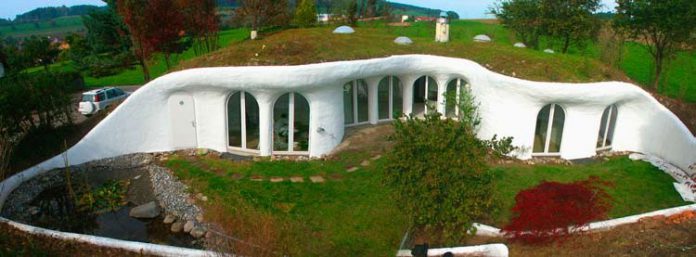The primary concern here is with so-called earth houses, aka earth berms, as opposed to rammed-earth or earth-sheltered homes.
Earth homes are set at least partially into the ground. The natural contours of the ground form part of the walls, with much of the house buried in soil. The earth provides insulation and protection from rain, low temperatures and wind.
Rather than being built under the ground, the homes are inserted into the landscape. The aim of an earth house is not to live under or in the ground but, rather, with it. The emphasis is on minimising the structure’s environmental footprint.
Earth homes are promoted as flexible in their construction, readily able to accommodate the wishes of their owners as to individuality, spatial requirements, energy conservation and, of course, being friends with the environment.
Their structural engineering allows for an organic sculptured design, with the house shaped to preserve the land’s natural contours.
Typically, modern earth houses are built with concrete walls and insulation. Peter Vetsch’s homes are constructed on a conventional foundation pad using sprayed concrete applied to a fine-meshed metal net which is curved to the shape of the planned rooms and welded over a supporting core.
A 200mm thick polyurethane foam is then sprayed onto the outside of the curved walls and arches to provide primary insulation. A fleece filter mat is laid over this and the building entombed in a layer of soil some 800mm to 3m thick. Loam rendering is applied to the interior walls to aid climate control, and they are then finished with white cement paint.
Early earth houses had few if any windows. Modern versions have wide glass facades at their fronts, with windows and/or solar tubes in the roof to provide natural light to internal rooms and to alleviate any cave effect. And, by the way, the entrances are often found in the roof.
And modern earth homes don’t stint on the latest interior finishing. While the curved walls can cause problems with interior decoration as, for example, in placing furniture, these issues are either anticipated during the design phase or fittings are customised.
Advantages touted for earth homes are primarily environmental. Their insulation keeps them cool in summer and warm in winter.
In winter, they possess a higher air humidity than conventional houses. They are impermeable and ideal for air conditioning and/or heat pumps. However, they must be properly ventilated to avoid mould or mildew growth.
They fit well into their natural surroundings and occupy far less land area than a conventional house. There is little reason they cannot be built right up to a boundary, and they are an ideal solution for steep and hilly properties.
Their structures are fireproof. They are more or less immune to wind and storm damage. And they offer significant protection from blast damage and fallout in the case of a nuclear war!
Peter Vetsch has built more than 47 earth homes in Switzerland and around the world.
Check out www.erdhaus.ch/main.php?fla=y&lang=en&cont=start.
And he is far from the only one at it. Google “The Burrow, Faulkners Lane, Harbledown” to check out a mere £2,000,000 earth home in Britain.




